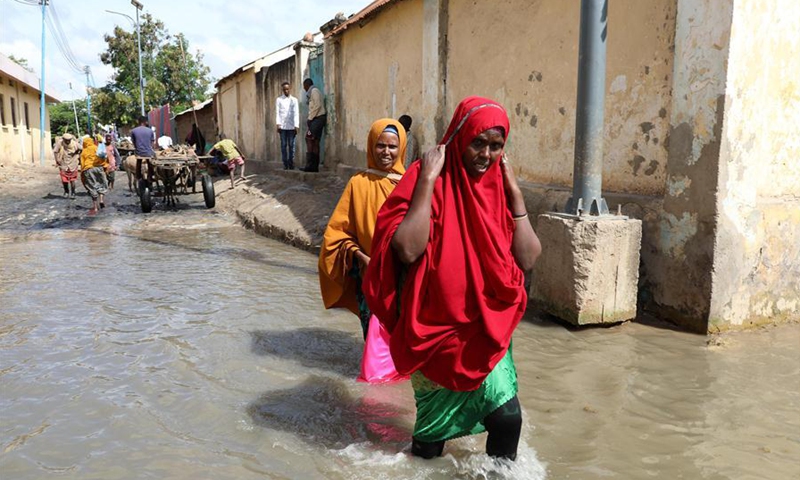Crisis drives millions toward hunger, threatens wildlife across region
Horn of Africa drought increases starvation

People wade through a flooded road in Afgoye, Somalia, Aug. 9, 2020. More than 150,000 Somalians have fled their homes since June due to flash and riverine flooding in the southern regions of this Horn of Africa nation, Farhan Haq, deputy spokesman for UN Secretary-General Antonio Guterres, told journalists at a virtual press briefing on Friday. (Photo by Hassan Bashi/Xinhua)
From southern Ethiopia to northern Kenya and Somalia, swathes of land across the Horn of Africa are being ravaged by a drought that has put 20 million people at risk of starvation.
A donor conference last week raised almost $1.4 billion for the region, which the UN says is facing its worst drought in 40 years. In the afflicted areas, people eke out a living mainly from herding and subsistence farming.
They are experiencing their fourth consecutive poor rainy season since the end of 2020, a situation exacerbated by a locust invasion that wiped out crops between 2019 and 2021.
"The number of hungry people due to drought could spiral from the currently estimated 14 million to 20 million through 2022," the UN's World Food Programme (WFP) said in April 2022.
Six million Somalis, are facing extreme levels of food insecurity and there is "a very real risk of famine in the coming months" if current conditions prevail, the UN humanitarian response agency OCHA said last week. Another 6.5 million people in Ethiopia are "acutely food insecure," it said, as well as 3.5 million in Kenya.
Across the region, 1 million people have been driven from their homes by a lack of water and pasture, and at least 3 million head of livestock have perished, OCHA said.
"We must act now... if we want to prevent a humanitarian catastrophe," the Food and Agriculture Organization's representative to the African Union, Chimimba David Phiri, said at a UN briefing in April.
Experts say extreme weather events are happening with increased frequency and intensity due to climate change.
Dire conditions in the Horn of Africa have been amplified by the war in Ukraine, which has contributed to soaring food and fuel costs, disrupted global supply chains and diverted aid money away from the region.
UNICEF executive director Catherine Russell said 10 million children in Djibouti, Ethiopia, Kenya and Somalia were in need of urgent life-saving support because of the crisis.
"Overall 1.7 million children are severely malnourished across the sub-region," she said in a statement after a four-day visit to Ethiopia last week.
Russell said a lack of clean water was increasing the risk of disease among children, while hundreds of thousands had dropped out of school, many having to travel long distances in search of food and water.
East Africa endured a harrowing drought in 2017 but early humanitarian action averted a famine in Somalia.
Wildlife is also at risk. In Kenya, there have been many cases of animals such as giraffes or antelopes perishing for lack of water and food, their carcasses rotting on barren scrubland.
In drought conditions, wild animals will leave their usual habitat for water or food, straying closer to developed areas.
In central Kenya, big cats were reported attacking herds of livestock, while elephants or buffaloes taking to grazing in local farmland, which have angered the inhabitants.
AFP


